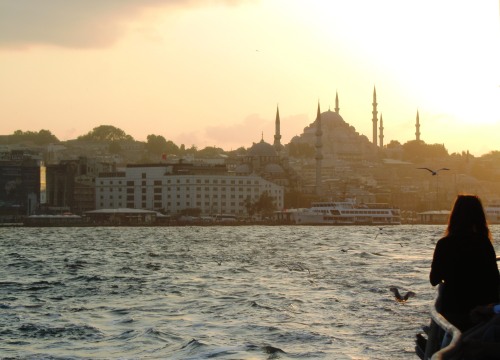
ANAMED 2015–2016 Fellow Aroa Garcia-Suarez compares life in Istanbul, a megalopolis with more than 8,000 years of history and 14 million inhabitants, to the prehistoric inhabitants of Çatalhöyük, the world’s first known city…
Istanbul today is a thriving city with more than 8,000 years of history and 14 million inhabitants – pretty intimidating when you come from a tiny coastal village where there are literally more cows than people! Adapting to life in this megalopolis has been a great challenge: the senses become overpowered with smells, sounds, and an inexplicable energy that emerges from the streets, the hustle and bustle of city life.
Having devoted a great deal of my professional career to investigating prehistoric hunter-gatherer lifestyles, I have always perceived urban agglomerations as something fascinating, almost daunting. It becomes unavoidable for an archaeologist like me to reflect on the fact that the processes that culminated in our modern cityscapes started more than 10,000 years ago, with the first settled communities in the Levant. Since 2012, I have been involved in studying these early sedentary societies in the Konya Plain, conducting research at a number of Neolithic sites including Boncuklu (9th–8th millennium BC) and Çatalhöyük (8th–6th millennium BC). The latter – occupied over 1,000 years and displaying a highly clustered settlement pattern, with houses rebuilt atop one another and no defined streets between them – has been hailed by some, since its discovery in the 1960s, as the world’s first known city. The wall paintings and human burials unearthed inside the densely-packed buildings at this site do not fail to captivate the imagination, and I cannot help but wonder if the prehistoric inhabitants of Çatalhöyük ever felt as overwhelmed in their allegedly heavily populated settlement as I do every time I step into the always crowded Istiklal Avenue.
Due to its clustered pattern, moving from one place to another in Çatalhöyük was not an easy task and, more often than not, rooftops were used as areas of transit. Times have fortunately changed for the modern city dweller, who can now enjoy multiple means of transportation. Istanbul is possibly one of the very few cities in the world to offer the widest range of imaginable options: bus, dolmuş, taxi, ferry, tram, funicular, metro… I love using the public transport, witnessing how Istanbul changes in front of my eyes as the journey progresses, admiring its numerous historical remains that stand as a tangible testimony of the city’s rich past.
Perhaps the experience of living in the centre of Istanbul will finally help me understand why people gave up the itinerant life of hunting and gathering to cram themselves into settlements that entailed a very close coexistence with their neighbours. Only one thing is certain: whether marching on prehistoric marshlands looking for food, or rushing down the escalator of a tube station to be on time for work, we are forever doomed to keep moving.

